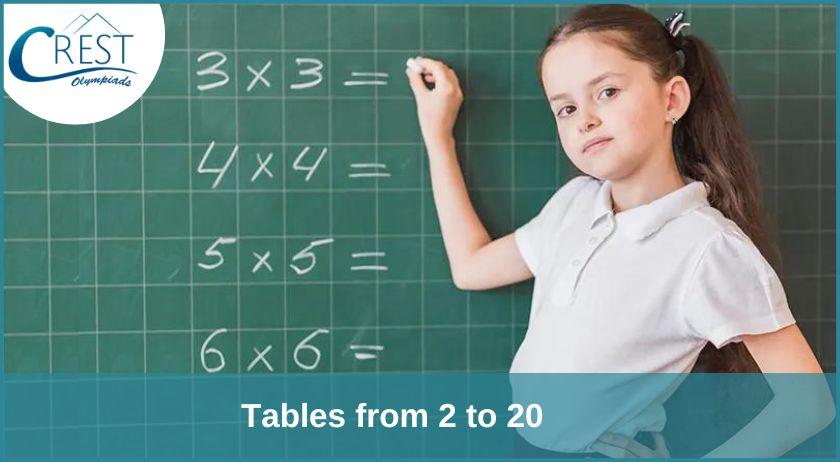The multiples of all the numbers from 2 to 20 are listed in the table. Memorizing tables 2 to 20 will be helpful for students who are preparing for the various Maths Olympiad exams and even in their regular school studies to solve multiplication-related problems quickly. Tables also allow for performing multiplication, division, fraction, ratio and other mathematical operations. These tables aid in improving students' problem-solving capacity. Since we have calculators at our convenience, it is always good to memorize the multiplication tables from 2 to 20.
These tables are the base of arithmetic. Hence, it is very important for students to learn the tables from 2 to 20. Students can also grab tricks to learn these tables and remember them for quick calculations.
But how can one learn these tables?
Students will learn multiplication tables from 2 to 20 in this short lesson. Students will also be presented with various tips and hacks for these multiplication tables. To help students prioritize and plan their revision, we have also provided multiplication tables 2 to 20 for download.
Tables from 2 to 10
Tables 2 to 10 are the base of mathematical calculations. Students must learn the Math tables 1 - 10 to improve computation accuracy and speed. For the purpose of avoiding errors in long calculations, it is essential to understand the concept of Math tables 1 - 10. Let’s memorize multiplication tables 2 to 10 now!
Tables from 2 to 5
| Table of 2 | Table of 3 |
| 2 × 1 = 2 | 3 × 1 = 3 |
| 2 × 2 = 4 | 3 × 2 = 6 |
| 2 × 3 = 6 | 3 × 3 = 9 |
| 2 × 4 = 8 | 3 × 4 = 12 |
| 2 × 5 = 10 | 3 × 5 = 15 |
| 2 × 6 = 12 | 3 × 6 = 18 |
| 2 × 7 = 14 | 3 × 7 = 21 |
| 2 × 8 = 16 | 3 × 8 = 24 |
| 2 × 9 = 18 | 3 × 9 = 27 |
| 2 × 10 = 20 | 3 × 10 = 30 |
| Table of 4 | Table of 5 |
| 4 × 1 = 4 | 5 × 1 = 5 |
| 4 × 2 = 8 | 5 × 2 = 10 |
| 4 × 3 = 12 | 5 × 3 = 15 |
| 4 × 4 = 16 | 5 × 4 = 20 |
| 4 × 5 = 20 | 5 × 5 = 25 |
| 4 × 6 = 24 | 5 × 6 = 30 |
| 4 × 7 = 28 | 5 × 7 = 35 |
| 4 × 8 = 32 | 5 × 8 = 40 |
| 4 × 9 = 36 | 5 × 9 = 45 |
| 4 × 10 = 40 | 5 × 10 = 50 |
Tables from 6 to 10
| Table of 6 | Table of 7 | Table of 8 |
| 6 × 1 = 6 | 7 × 1 = 7 | 8 × 1 = 8 |
| 6 × 2 = 12 | 7 × 2 = 14 | 8 × 2 = 16 |
| 6 × 3 = 18 | 7 × 3 = 21 | 8 × 3 = 24 |
| 6 × 4 = 24 | 7 × 4 = 28 | 8 × 4 = 32 |
| 6 × 5 = 30 | 7 × 5 = 35 | 8 × 5 = 40 |
| 6 × 6 = 36 | 7 × 6 = 42 | 8 × 6 = 48 |
| 6 × 7 = 42 | 7 × 7 = 49 | 8 × 7 = 56 |
| 6 × 8 = 48 | 7 × 8 = 56 | 8 × 8 = 64 |
| 6 × 9 = 54 | 7 × 9 = 63 | 8 × 9 = 72 |
| 6 × 10 = 60 | 7 × 10 = 70 | 8 × 10 = 80 |
| Table of 9 | Table of 10 |
| 9 × 1 = 9 | 10 × 1 = 10 |
| 9 × 2 = 18 | 10 × 2 = 20 |
| 9 × 3 = 27 | 10 × 3 = 30 |
| 9 × 4 = 36 | 10 × 4 = 40 |
| 9 × 5 = 45 | 10 × 5 = 50 |
| 9 × 6 = 54 | 10 × 6 = 60 |
| 9 × 7 = 63 | 10 × 7 = 70 |
| 9 × 8 = 72 | 10 × 8 = 80 |
| 9 × 9 = 81 | 10 × 9 = 90 |
| 9 × 10 = 90 | 10 × 10 = 100 |
Tables from 11 to 20
It is necessary for students to memorize tables from 11 to 20 to build a good speed in solving Maths problems, especially for primary and secondary school students. Students can find the Math multiplication tables 11 to 20 here.
Tables from 11 to 15
| Table of 11 | Table of 12 | Table of 13 |
| 11 × 1 = 11 | 12 × 1 = 12 | 13 × 1 = 13 |
| 11 × 2 = 22 | 12 × 2 = 24 | 13 × 2 = 26 |
| 11 × 3 = 33 | 12 × 3 = 36 | 13 × 3 = 39 |
| 11 × 4 = 44 | 12 × 4 = 48 | 13 × 4 = 52 |
| 11 × 5 = 55 | 12 × 5 = 60 | 13 × 5 = 65 |
| 11 × 6 = 66 | 12 × 6 = 72 | 13 × 6 = 78 |
| 11 × 7 = 77 | 12 × 7 = 84 | 13 × 7 = 91 |
| 11 × 8 = 88 | 12 × 8 = 96 | 13 × 8 = 104 |
| 11 × 9 = 99 | 12 × 9 = 108 | 13 × 9 = 117 |
| 11 × 10 = 110 | 12 × 10 = 120 | 13 × 10 = 130 |
| Table of 14 | Table of 15 |
| 14 × 1 = 14 | 15 × 1 = 15 |
| 14 × 2 = 28 | 15 × 2 = 30 |
| 14 × 3 = 42 | 15 × 3 = 45 |
| 14 × 4 = 56 | 15 × 4 = 60 |
| 14 × 5 = 70 | 15 × 5 = 75 |
| 14 × 6 = 84 | 15 × 6 = 90 |
| 14 × 7 = 98 | 15 × 7 = 105 |
| 14 × 8 = 112 | 15 × 8 = 120 |
| 14 × 9 = 126 | 15 × 9 = 135 |
| 14 × 10 = 140 | 15 × 10 = 150 |
Tables from 16 to 20
| Table of 16 | Table of 17 | Table of 18 |
| 16 × 1 = 16 | 17 × 1 = 17 | 18 × 1 = 18 |
| 16 × 2 = 32 | 17 × 2 = 34 | 18 × 2 = 36 |
| 16 × 3 = 48 | 17 × 3 = 51 | 18 × 3 = 54 |
| 16 × 4 = 64 | 17 × 4 = 68 | 18 × 4 = 72 |
| 16 × 5 = 80 | 17 × 5 = 85 | 18 × 5 = 90 |
| 16 × 6 = 96 | 17 × 6 = 102 | 18 × 6 = 108 |
| 16 × 7 = 112 | 17 × 7 = 119 | 18 × 7 = 126 |
| 16 × 8 = 128 | 17 × 8 = 136 | 18 × 8 = 144 |
| 16 × 9 = 144 | 17 × 9 = 153 | 18 × 9 = 162 |
| 16 × 10 = 160 | 17 × 10 = 170 | 18 × 10 = 180 |
| Table of 19 | Table of 20 |
| 19 × 1 = 19 | 20 × 1 = 20 |
| 19 × 2 = 38 | 20 × 2 = 40 |
| 19 × 3 = 57 | 20 × 3 = 60 |
| 19 × 4 = 76 | 20 × 4 = 80 |
| 19 × 5 = 95 | 20 × 5 = 100 |
| 19 × 6 = 114 | 20 × 6 = 120 |
| 19 × 7 = 133 | 20 × 7 = 140 |
| 19 × 8 = 152 | 20 × 8 = 160 |
| 19 × 9 = 171 | 20 × 9 = 180 |
| 19 × 10 = 190 | 20 × 10 = 200 |
Tricks for Maths Tables from 2 to 20
In this section, we'll try to learn some table tricks to help remember tables from 2 to 20 in a better way.
- In the multiplication tables from 2 to 20, every number is a whole number.
- Table of 2 has the following digit placement pattern: 2, 4, 6, 8 and 0.
- When a number is multiplied by 2, it is increased by two times, or it is doubled. For example, 2 times 6 means that the number 6 has been doubled; thus, the result is 12. Table 2 can be written as 2, 4, 6, 8, 10, 12, 14, 16, 18, and 20.
- The last digit of the multiples in the table of 5 is either 0 or 5.
Multiplying an even number by 6 yields the same even number as the last digit of the product. For example: 6 × 4 = 24, 6 × 6 = 36, 6 × 8 = 48. - You can find the result of multiplying 11 by whole numbers in the multiplication table for the number 11. Compared to other multiplication tables, learning the table of 11 is relatively simple. The multiples always consist of the same digit repeated a few times, for example, 11 x 1 = 11, 11 x 2 = 22, 11 x 5 = 55, 11 x 9 = 99, etc.
- In the multiplication table of 12, one can see that there is a fixed pattern for each of the five multiples of 12, namely 12, 24, 36, 48, 60, 72, 84, 96, 108, 120, and so on.
- You must first learn the 3 times table in order to master the 13 multiplication table. The numbers 3, 6, 9, 12, 15, 18, 21, and so forth are the multiples of three. Now, add natural numbers to the tenth digit to get the multiples of 13. Therefore, using the following formula, one can arrive at the table of 13: (1 + 0)3, (2 + 0)6, (3 + 0)9, (4 + 1)2, (5 + 1)5, (6 + 1)8, (7 + 2)1, (8 + 2)4, (9 + 2)7, (10 + 3)0 = 13, 26, 39, 52, 65, 78, 91, 104, 117, and 130.
- Students must first learn the 4 times table in order to master the 14 multiplication table. As a result, 4, 8, 12, 16, 20, 24, 28, 32, 36, and so forth are the multiples of 4. Now, add natural numbers to the tenth digit to get the multiples of 14. As a result, the following operations can be used to generate the table of 14: (1 + 0)4, (2 + 0)8, (3 + 1)2, (4 + 1)6, (5 + 2)0, (6 + 2)4, (7 + 2)8, (8 + 3)2, (9 + 3)6, (10 + 4)0. The final multiples will therefore add up to the numbers 14, 28, 42, 56, 70, 84, 98, 112, 126, 140 and so forth.
- There is a secret trick to learning the multiplication table for 15 quickly. You should have a basic understanding of one's place digits, ten's place digits, odd numbers and even numbers in order to master this trick. The trick is that the one's place will always follow the pattern of 5-0 in the results. For instance, 15 multiplied by one equals 15 or 15 multiplied by two equals 30. Additionally, the digits always follow the pattern of two consecutive even numbers followed by two consecutive odd numbers for the place value of ten. For example - 15 x 1 = 15 (odd number at ten’s place), 15 x 2 = 30 (odd number at ten’s place), 15 x 3 = 45 (even number at ten’s place), and 15 x 4 = 60 (even number at ten’s place).
- In the table of 16, there is a definite pattern for every 5 multiples of 16 that is: 16, 32, 48, 64, 80, 96, 112, 128, 144, 160 and so on. The last digit of these multiples is always repeating.
- To obtain the table for 17, one can also consider the table for 16 and the table for 18.
- In the 18’s table, subtract the natural numbers from 1 to 10 and multiply by 18 to get the resulting values in the table of 17. Additionally, in the 16’s table, we get the 17’ table by adding those natural numbers to the product of the 16’ table’s multiples.
- It may surprise you to learn that the multiplication table for 18 includes double multiples that are found in the table for 9.
- There is a pattern in table 19 for each multiple of ten. In the tens place, write the first ten odd numbers in a sequence. Start writing the numbers 0 to 9 in the unit's location now, starting from the reverse side.
- The multiplication of the 20’s table is really quite simple. We just need to learn the 2’s table and then add a 0 in the one’s place and we will have the resultant value of the 20’s multiplication table.
In the next part, we are providing solved examples that will help students to practice the tables from 2 to 20.
PDF for Multiplication Tables 2 to 20
Here are the multiplication tables from 2 to 20. Students can access the following link to download these math tables:
Download PDF for Tables 2 to 20
Example Questions for Tables 2 to 20
Example 1: Observe all the tables from 2 to 20
- Compute 2 times 19
- Product of 12 and 6
Solution:
a) First, we will observe all the arrays from 2 to 20 and write 2 times 19 mathematically, 2 times 19 = 2 × 19 = 38
Thus we get 2 times 19 which is 38.
b) First, we will mathematically write the product of 12 and 6. Using the multiplication table by 12, the product of 12 and 6 = 12 × 6 = 72.
Therefore, the product of 12 and 6 according to tables 2 to 20 is 72.
Example 2: Is the product of 7 and 9 an odd or an even number? Evaluate.
Solution:
The product of 7 and 9;
According to the 7 times table, 7 x 9 = 63
63 is an odd number.
Example 3: If Priya brought 3 ribbons for 10 rupees each, then what is the total cost of the ribbons?
Solution:
Number of ribbons Priya bought = 3
Price of one ribbon = Rs. 10
Total costs of ribbons = 3 x 10 = Rs. 30
Solve!!!
- What is 16 times 7?
- Find the value of 9 × 7 = ?
- What is 14 times 3 equal to?
- What is the value of 17 × 5?
Conclusion
Thus, this was all about tables 2 to 20. I hope the students understood and can later decode the tables in an easier way, which will help them learn the tables faster and memorize them for a longer period of time.
Students can also practice the problem sums and compare their answers to those we provide. Additionally, print the free pdf for tables 2 to 20 after downloading and post it to your wall and refer to it frequently to learn the tables quickly.








